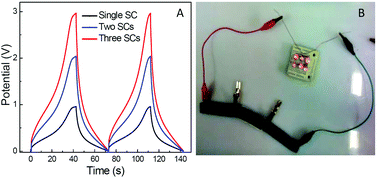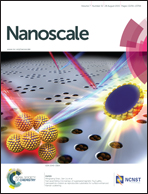Faradic redox active material of Cu7S4 nanowires with a high conductance for flexible solid state supercapacitors†
Abstract
The exploration of high Faradic redox active materials with the advantages of low cost and low toxicity has been attracting great attention for producing high energy storage supercapacitors. Here, the high Faradic redox active material of Cu7S4-NWs coated on a carbon fiber fabric (CFF) is directly used as a binder-free electrode for a high performance flexible solid state supercapacitor. The Cu7S4-NW-CFF supercapacitor exhibits excellent electrochemical performance such as a high specific capacitance of 400 F g−1 at the scan rate of 10 mV s−1 and a high energy density of 35 Wh kg−1 at a power density of 200 W kg−1, with the advantages of a light weight, high flexibility and long term cycling stability by retaining 95% after 5000 charge–discharge cycles at a constant current of 10 mA. The high Faradic redox activity and high conductance behavior of the Cu7S4-NWs result in a high pseudocapacitive performance with a relatively high specific energy and specific power. Such a new type of pseudocapacitive material of Cu7S4-NWs with its low cost is very promising for actual application in supercapacitors.



 Please wait while we load your content...
Please wait while we load your content...